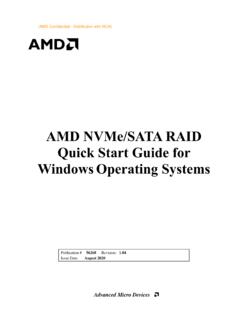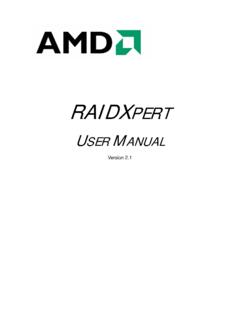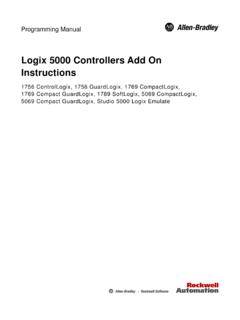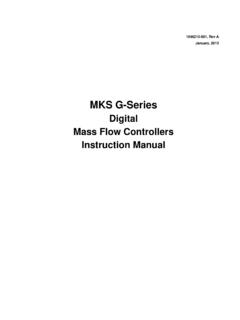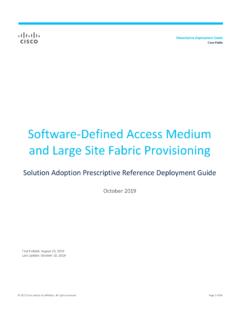Transcription of AMD RAID Quick Start Guide
1 1 | P a g e AMD Ryzen Threadripper NVMe RAID Quick Start Guide Release Version 2 | P a g e Contents 1 GENERAL INFORMATION .. 3 Purpose .. 3 System requirements .. 3 Information about supported Configuration by installer with this release: - .. 4 Generic system setup .. 4 2 BOOTABLE ARRAYS .. 5 Copy AMD-RAID drivers to a removeable storage medium: Windows .. 5 3 Pre-Installation Steps .. 6 Platform BIOS Settings - Enable RAID .. 6 4 Create the Bootable Virtual Disk .. 6 RAIDX pert2 Configuration Utility (HII Mode) .. 6 UEFI Mode .. 7 5 Install AMD-RAID Drivers .. 8 Windows: Install AMD-RAID UEFI drivers during Windows OS installation .. 8 Install the AMD-RAID UEFI drivers during Windows 10 OS Installation .. 8 6 Install the AMD-RAIDX pert2 Management Suite and Web GUI.
2 9 Windows AMD-RAIDX pert2 Management Suite .. 9 Windows AMD RAIDX pert2 Management Suite Installation (Manually) .. 9 3 | P a g e 1 GENERAL INFORMATION Purpose This Installation Guide is designed to assist with system setup in RAID Mode, by performing these general procedures : Copy device drivers to removable storage media for the following operating systems: Microsoft Windows 10 x64 Loading the device drivers on a system at the time that the Windows operating system is installed, then loading the AMD-RAIDX pert2 (Web GUI) System requirements Component Requirements Memory (RAM) Minimum: 8 GB Recommended: 32 GB Hard Disk One to Fourteen SATA HDD s, SATA SSD s or NVMe Max number of NVMe devices 10 Max controller Count 11 (2 controller with Device ID 7917, 1 controller with device ID 43BD and NVMe (1 controller per NVMe) Supported AMD Controllers AMD SP3-Series Chipsets Systems used for testing Summit SP3 based Whitehaven s 4 | P a g e Information about supported Configuration by installer with this release: - Generic system setup A generic system setup process is described below.)
3 1. Copy the AMD-RAID drivers to a removable storage medium. (Refer to Section ) 2. Power-on the system. 3. Access the platform BIOS window for the system a. For supported AMD chipsets, set the SATA mode as RAID or enable NVMe RAID. (Refer to Section ) b. This enables the loading of the AMD-RAID UEFI driver 4. Initialize the disks, using the RAIDX pert2 Configuration Utility or UEFI driver. (Refer to Section ) 5. Create arrays, using the HII Configuration Utility or UEFI driver. 6. Load the AMD-RAID drivers during the system operating system installation. (Refer to Section ) 7. Complete the rest of the operating system installation. 8. Install the OS RAID Management Suite (AMD RAIDX pert2). (Refer to Section ) IMPORTANT: To protect your data; always perform a backup prior to installing any new, major hardware or software.
4 If you are adding NVMe as RAID to your existing RAID arrays then update all existing RAID controller drivers to latest version and reboot the system. Later connect NVMe and install RAID driver on the NVMe devices. OS Loaded in Drive RAID controller in BIOS NVME/ RAID mode in PBS BIOS Option Status Device ID 43BD Device ID 7917 SoC RAID SATA SATA RAID CATALYST INSTALL MANAGER should prompt user to install RAID driver with Warning Message SoC RAID RAID RAID RAID CATALYST INSTALL MANAGER should prompt user to install RAID driver with Warning Message NvMe RAID RAID NvMe RAID Driver installation shall be blocked for all controllers raid /NVMe SATA SATA RAID CATALYST INSTALL MANAGER should prompt user to install RAID driver with Warning Message SoC RAID SATA SATA NvMe CATALYST INSTALL MANAGER should prompt user to install RAID driver with Warning Message NvMe SATA SATA NvMe RAID Driver installation shall be blocked for all controllers SoC RAID RAID RAID
5 NvMe (But no NVMe devices are connected to the system) RAID driver installation should happen for AMD and PT controllers SoC RAID SATA RAID RAID Not supported with this release SoC RAID RAID SATA RAID Not supported with this release 5 | P a g e Before you Have the Windows operating system installation media available and ready to install. 2 BOOTABLE ARRAYS NOTE: Windows : Removeable storage (Flash Driver) required for Copying AMD-RAID drivers Copy AMD-RAID drivers to a removeable storage medium: Windows A removable storage medium is needed when the OS is installed to an AMD-RAID bootable array. 1. Power-on the system. 2. Locate and use a system that is running a Windows operating system and has a CD DVD drive or an I/O port for removable storage media (such as a USB flash drive).
6 3. Go to a browser and access the web site of your system supplier or motherboard vendor. 4. Insert the storage medium into the system: Windows 10 : Connect a USB flash drive to a USB I/O port, or insert a blank CD-DVD disk into the applicable drive. 5. Download the AMD-RAID drivers from the web site to the appropriate removable storage medium. 6. Proceed to Windows: Install AMD-RAID drivers during a Windows OS installation. 6 | P a g e 3 Pre-Installation Steps NOTE: The steps mentioned here are specific to AMD NDA BIOS based off the AMI BIOS. The steps for Other BIOS Vendors will be different. Platform BIOS Settings - Enable RAID 1. Power-on the system. 2. Press ESC to get into the Platform BIOS 3. Set or configure Advanced -> AMD PBS -> NVMe RAID Mode=Enabled 4.
7 Set or configure Advanced -> AMD CBS -> FCH common Options -> SATA Configuration Options -> SATA controller to Enabled. 5. Set or configure Advanced -> AMD CBS -> FCH common Options -> SATA Configuration Options -> SATA Mode to RAID. 6. Set or configure the Advanced -> Promontory common Options -> PT SATA Configuration Options -> PT SATA Port Enable to Enabled. 7. Set or configure the Advanced -> Promontory common Options -> PT SATA Configuration Options -> PT SATA Mode to RAID. 8. Set or configure the Advanced -> CSM Configuration -> CSM Support -> Enabled 9. Set or configure the Advanced -> CSM Configuration -> Boot Option Filter to UEFI and Legacy or UEFI Only. 10. Set or configure the Advanced -> CSM Configuration -> Storage -> UEFI 11. Save and reboot.
8 4 Create the Bootable Virtual Disk RAIDX pert2 Configuration Utility (HII Mode) 1. Power-on the system. 2. Press ESC to get into the Platform BIOS 3. Select Advanced, RAIDX pert2 Configuration Utility, then press Enter 4. At the RAIDX pert2 Configuration Utility s Main Menu, use the arrow keys to select Array Management, then press Enter 5. Use the arrow keys to select Create Array, then press Enter 6. Select Select RAID Level, then press Enter a. From the Select RAID Level drop down menu, use the arrow keys to select the desired RAID level, then press Enter 7. Select the disks with which to create the array: a. Use the arrow keys to select Select Physical Disks, then press Enter b. To select individual disks, highlight a disk with the arrow keys and press the Space Bar or Enter.
9 Any number of disks may be selected using this method c. To select all disks, use the arrow keys to select Check All, then press Enter d. Use the arrow keys to select Apply Changes, then press Enter 8. Select an array size by doing the following: 7 | P a g e a. Use the arrow key to select Array Size, then press Enter b. The Array size will default to the Maximum size allowed by the number of physical disks and RAID level selected. If you want a smaller size Array size, enter the desired value. c. Press Enter when the desired size is reached. 9. Using the arrow keys to select Read Cache Policy, then press Enter a. Select the desired Read Cache Policy, then press Enter 10. Using the arrow keys to select Write Cache Policy, then press Enter a. Select the desired Write Cache Policy, then press Enter 11.
10 Use the arrow keys to select Create Array, then press Enter UEFI Mode 1. At the system s Power-On Self-Test (POST) screen, press F7 / F12 / ESC (or similar) to access the UEFI Configuration Utility (aka UEFI Boot Manager). 2. Boot to the EFI Internal shell Note: obtain the file from your system supplier or motherboard vendor and copy it onto a UEFI flash drive, in the root directory. 3. Enter fsx: where x is the number of the UEFI Flash Drive. 4. Use rcadm to create the desired Boot Virtual Disk. Examples: Note: the user may have to press the page up key to see more of the information. a. To Query the devices connected in the system: (Output will display the UEFI version, physical devices and arrays) M -qa b. Create a Volume on disk 1 with a size of 80 Gbs and disables Read/Write Cache: C v d 1 s 80000 ca nc c.

